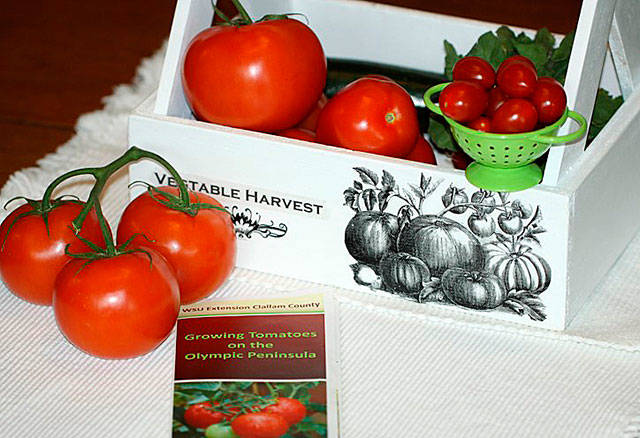Growing tomatoes in the moderate climate of the Pacific Northwest is more challenging than in a hot and humid environment. And enjoying ripe tomatoes from your garden is a challenge worth taking!
Site selection is critical. Tomato plants need 6-8 hours of sunlight each day. An ideal location is in full sun, on the south side of a building where plants will benefit from both direct and reflected heat.
Tomato plants also need ample air circulation to keep the leaves dry and prevent fungal problems, and should be protected from too much wind that will reduce air temperature around the plants.
Soil should be highly organic and well drained. If you are cultivating a new garden site, amend the soil by spading compost in the top 10 inches of soil. Consistent water delivery discourages flower drop, blossom end rot and fruit splitting.
If your garden site is less than ideal, consider modifying the environment: Create a raised bed to improve drainage and increase soil temperature; construct a hoop-house to increase air and soil temps, shelter plants from wind and protect leaves from moisture; or plant in large containers and move them to “follow the sun.”
Do a soil test (see sidebar for details) to ensure the plants have all of the nutrients they require and that the pH of the soil is between 5.5 to 6.8, the “Happy Zone” for tomato production.
Indeterminate or Determinate? Indeterminate (I) plants produce fruit over a longer period of time and are aggressive growers. Determinate (D) plants produce the majority of their fruit in a shorter period of time and usually are less aggressive growers. Both do best if the plants are supported rather than allowed to range. Position plants 4 feet center-to-center to ensure ample air circulation.
Select a tomato variety that grows well in the Pacific Northwest, such as: Early Girl (I ), Stupice (I), Sun Gold (I) and Oregon Spring (D).
Be patient and wait until soil temperature is 50 F or higher, usually late May or early June. If the soil temperature is too low, the plant will be unable to access adequate phosphorus causing the leaves to turn “purple” and compromise plant growth.
Prepare to plant! Dig and amend soil as needed. Arrange a soaker or drip hose along the row where the tomatoes will be planted. Have available: compost/mulch, cages (or other methods of support), a hand trowel, water, fish emulsion and slow-release organic 10-10-10 fertilizer.
Planting the tomato. Pinch off the lower leaves, keeping the highest 2-4 sets of leaves; remove blossoms (which will take energy away from roots). Dig hole deep enough for the roots (which you have opened up so there are no circling roots) and the stem up to within a few inches of the lowest set of leaves. Fill hole with water/fish emulsion (1 Tablespoon fish emulsion/gallon of water), let it absorb. Spread roots across bottom of hole, cover roots with soil, sprinkle ¼ cup of slow release organic 10-10-10 fertilizer over the soil, fill hole with remaining soil and firm around plant.
If plants are grafted, the graft union must be above soil level after soil has been firmed around plant. Position and secure a soaker or drip hose, add 3-4 inches of compost around plant, position and secure a tomato cage/support structure.
Tomatoes need about 1 inch of water per week (rain counts). Each month, water with fish emulsion/water mix. Keep leaves dry by watering only at soil level. Container plants need more frequent watering. One month after planting, feed again with 10-10-10 fertilizer.
Get involved
Mark your calendars and join the Master Gardeners at the following events:
On May 20, the Saturday in the Garden Series begins at the Woodcock Demonstration Garden. Master Gardener Cindy Ericksen presents on “Bee-centric Gardening” from 10-11 a.m. This lecture coincides with the first Plant Clinic of the year to be held at the same location in Sequim from 9:30 a.m.-12:30 pm.
On May 25, the Thursday Brown Bag lecture at the Clallam County Courthouse from noon-1 p.m. will feature Mike Barnes. His topic will be “Native Plants, Use and Propagation.”
On June 24, the annual Garden Tour is set for 10 a.m.-4 p.m. This year’s tour will feature some beautifully landscaped yards in Sequim. Keep your eye on the Sequim Gazette, as the advertising for this event will appear anytime now! For ticket sales and garden locations visit http://ext100.wsu.edu/clallam.
Judy English is a Clallam County Master Gardener.


